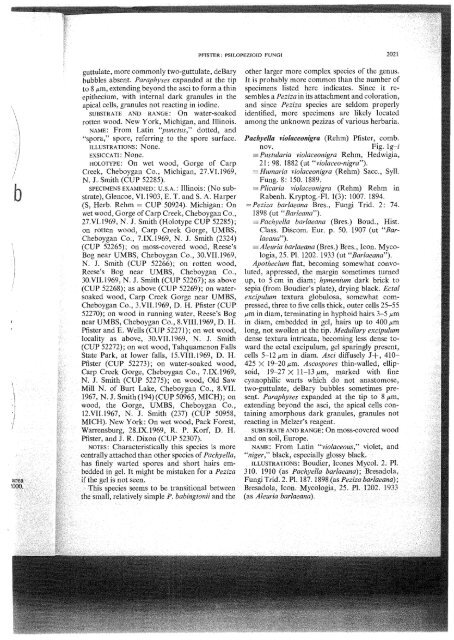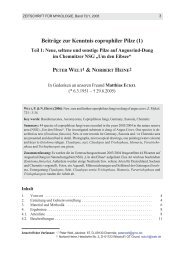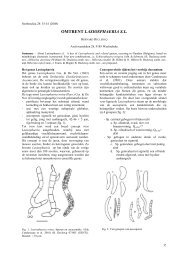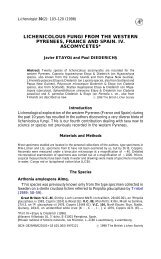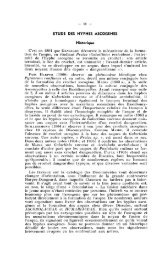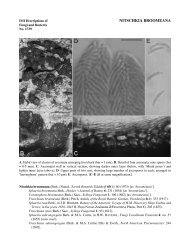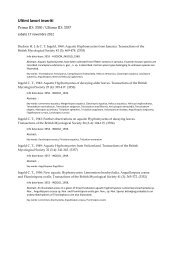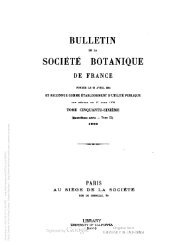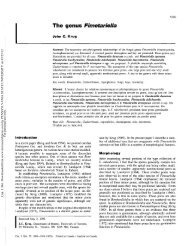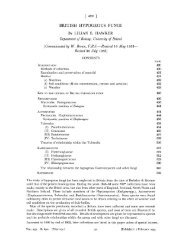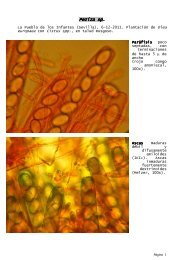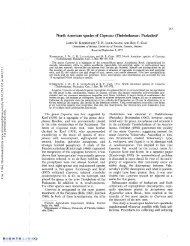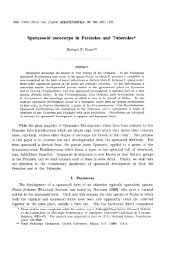Pfister-1973-The-psilopezioid-fungi-IV-Pachyella-0001 - ASCOfrance
Pfister-1973-The-psilopezioid-fungi-IV-Pachyella-0001 - ASCOfrance
Pfister-1973-The-psilopezioid-fungi-IV-Pachyella-0001 - ASCOfrance
Create successful ePaper yourself
Turn your PDF publications into a flip-book with our unique Google optimized e-Paper software.
guttulate, more commonly two-guttulate, deBary<br />
bubbles absent. Paraphyses expanded at the tip<br />
to 8 pm, extending beyond the asci to form a thin<br />
epithecium, with internal dark granules in the<br />
apical cells, granules not reacting in iodine.<br />
SUBSTRATE AND RANGE: On water-soaked<br />
rotten wood. New York, Michigan, and Illinois.<br />
NAME: From Latin "punctus," dotted, and<br />
'spora," spore, referring to the spore surface.<br />
ILLUSTRATIONS : None.<br />
EXSICCATI : None.<br />
HOLOTYPE: On wet wood, Gorge of Carp<br />
Creek, Cheboygan Co., Michigan, 27.VI.1969,<br />
N. J. Smith (CUP 52285).<br />
SPECIMENS EXAMINED: U.S.A. : Illinois: (NO sub-<br />
strate), Glencoe, VI. 1903, E. T. and S. A. Harper<br />
(S, Herb. Rehm = CUP 50924). Michigan: On<br />
wet wood, Gorge of Carp Creek, Cheboygan Co.,<br />
27.VI. 1969, N. J. Smith (Holotype CUP 52285);<br />
on rotten wood, Carp Creek Gorge, UMBS,<br />
Cheboygan Co., 7.IX.1969, N. J. Smith (2324)<br />
(CUP 52265) ; on moss-covered wood, Reese's<br />
Bog near UMBS, Cheboygan Co., 30.VII. 1969,<br />
N. J. Smith (CUP on rotten wood,<br />
Reese's Bog near Cheboygan Co.,<br />
30.VIL 1969, N. J. S P 52267); as above<br />
(CUP 52268); as above (CUP 52269); on water-<br />
soaked wood, Carp Creek<br />
Cheboygan Co., 3.VII. 1969<br />
52270); on wood in runnin<br />
near UMBS, Cheboygan Co., 8.VIII. 1969, D. H.<br />
<strong>Pfister</strong> and E. Wells (CUP 5227 1); on wet wood,<br />
y as above, 30.VII.1969, N. J. Smith<br />
52272); on wet wood, Tahquamenon Falls<br />
Park, at lower falls, 15.VIII.1969, D. H.<br />
ster (CUP 52273); on water-soaked wood,<br />
Carp Creek Gorge, Cheboygan Co., 7.1X.1969,<br />
J. Smith (CUP 52275); on wood, Old Saw<br />
ill N. of Burt Lake, Cheboygan Co., 8.VII.<br />
67, N. J. Smith (1 94) (CUP 50965, MICH); on<br />
ood, the Gorge, UMBS, Cheboygan Co.,<br />
12.VII.1967, N. J. Smith (237) (CUP 50958,<br />
MICH). New York: On wet wood, Pack Forest,<br />
Warrensburg, 28.1X.1969, R. P. Korf, D. H.<br />
xon (CUP 52307).<br />
istically this species is more<br />
an other species of <strong>Pachyella</strong>,<br />
res and short hairs em-<br />
be mistaken for a Peziza<br />
be transitional between<br />
pie P. babingtonii and the<br />
PFISTER: PSILOPEZIOlD FUNGI 202 1<br />
other larger more complex species of the genus.<br />
It is probably more common than the number of<br />
specimens listed here indicates. Since it re-<br />
sembles a Peziza in its attachment and coloration,<br />
and since Peziza species are seldom properly<br />
identified, more specimens are likely located<br />
among the unknown pezizas of various herbaria.<br />
<strong>Pachyella</strong> violaceonigra (Rehm) <strong>Pfister</strong>, comb.<br />
nov. Fig. lg-i<br />
= Pustularia violaceonigra Rehm, Hedwigia,<br />
2 1 : 98. 1882 (ut "violaceo-nigra").<br />
Â¥ Humaria violaceonigra (Rehm) Sacc., Syll.<br />
Fung. 8 : 150. 1889.<br />
=Plicaria violaceonigra (Rehm) Rehm in<br />
Rabenh. Kryptog-Fl. l(3): 1007. 1894.<br />
=Peziza barlaeana Bres., Fungi Trid. 2: 74.<br />
1898 (ut "Barleana").<br />
dachyella barlaeana (Bres.) Boud., Hist.<br />
Class. Discom. Eur. p. 50. 1907 (ut "Bar-<br />
laeana"),<br />
== Aleuria barlaeana (Bres.) Bres., Icon. Myco-<br />
logia, 25. PI. 1202. 1933 (ut "Barlaeana").<br />
Apothecium flat, becoming somewhat convo-<br />
luted, appressed, the margin sometimes turned<br />
up, to 5 cm in diam; hymenium dark brick to<br />
sepia (from Boudier's plate), drying black. Ectal<br />
excipulum textura globulosa, somewhat com-<br />
pressed, three to five cells thick, outer cells 25-55<br />
pm in diam, terminating in hyphoid hairs 3-5 pm<br />
in diam, embedded in gel, hairs up to 400 pm<br />
long, not swollen at the tip. Medullary excipulum<br />
dense textura intricata, becoming less dense to-<br />
ward the ectal excipulum, gel sparingly present,<br />
cells 5-1 2 pm in diam. Asci diffusely J+ , 4 10-<br />
425 X 19-20 pm. Ascospores thin-walled, ellip-<br />
soid, I 9-27 X 1 1-13 pm, marked with fine<br />
cyanophilic warts which do not anastomose,<br />
- -<br />
two-guttulate, deBary bubbles sometimes pre-<br />
sent. Paraphyses expanded at the tip to 8 pm,<br />
extending beyond the asci, the apical cells con-<br />
- .<br />
taining amorphous dark granules, granules not<br />
reacting in Melzer's reagent.<br />
SUBSTRATE AND RANGE : On moss-covered wood<br />
and on soil, Europe.<br />
NAME: From Latin "violaceous," violet, and<br />
"niger," black, especially glossy black.<br />
ILLUSTRATIONS : Boudier, Icones Mycol. 2. PI.<br />
3 10. 19 10 (as PachyeUa barlaeana); Bresadola,<br />
Fungi Trid .2. PI. 1 8 7. 1 898 (as Peziza barlaeana) ;<br />
Bresadola, Icon. Mycologia, 25. PI. 1202. 1933<br />
(as Aleuria barlaeana).


